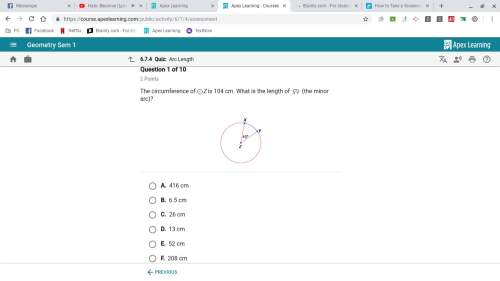
Mathematics, 06.04.2021 17:50 Thelazysandwich
The vertices of figure EFGH have coordinates E(1, 3), F(2, 5), G(4, 4), and H(3, 3). The vertices of figure E'F'G'H' have coordinates E′(3, -1), F′(4, 1), G′(6, 0), and H′(5, -1).
Which transformation of figure EFGH produced figure E'F'G'H' ?
a reflection across the x-axis
a translation 2 units left and 4 units up
a translation 2 units right and 4 units down
a reflection across the y-axis

Answers: 2


Another question on Mathematics

Mathematics, 21.06.2019 12:50
What values of data might affect the statistical measures of spread and center
Answers: 1

Mathematics, 21.06.2019 16:30
If 10 men take 18 days to mow 60 acres of grass, how long will 15 men take to mow 80 acres?
Answers: 3

Mathematics, 21.06.2019 16:50
Which is a true statement about an exterior angle of a triangle a. it is formed by two segments that are not sides of the triangle, b. it forms a linear pair with one of the interior angles of the triangle, c. it is complementary to one of the interior angles of the triangle. d. it is formed by two segments that are sides of the triangle.
Answers: 2

Mathematics, 21.06.2019 17:00
For the rule of 78, for a 12-month period, the last term in the sequence is 12 and the series sums to 78. for an 10 month period, the last term is and the series sum is . for a 15 month period, the last term is and the series sum is . for a 20 month period, the last term is and the series sum is
Answers: 2
You know the right answer?
The vertices of figure EFGH have coordinates E(1, 3), F(2, 5), G(4, 4), and H(3, 3). The vertices of...
Questions

Mathematics, 30.05.2020 16:58







Spanish, 30.05.2020 16:58




Mathematics, 30.05.2020 16:58


Mathematics, 30.05.2020 16:58


History, 30.05.2020 16:58



Arts, 30.05.2020 16:58





